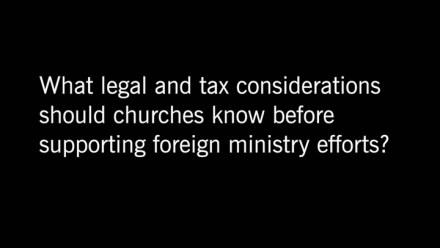Foreign mission work offers churches powerful opportunities to expand their impact globally. However, these activities come with complex legal and tax requirements. Understanding the rules is essential for maintaining compliance and ensuring your mission’s success.
Key Areas to Understand
Tax-Deductible Contributions
Donors often want to claim tax deductions for gifts supporting foreign missions. To meet Internal Revenue Service (IRS) requirements, churches must:
- Maintain full control over donated funds.
- Confirm that the recipient uses the funds solely for charitable purposes.
- Avoid acting as a conduit—don’t pass along designated gifts directly to individuals or foreign entities without oversight.
Example:
A gift specifically designated for a missionary is not tax-deductible unless the church retains discretion over how the funds are used.
To stay compliant:
- Require and retain proper documentation from the recipient.
- Regularly review and confirm how funds are used.
- Require a qualifying grant agreement with the recipient.
Short-Term Mission Trip Guidelines
Mission trip expenses are usually tax-deductible—if the trip’s primary purpose is charitable.
To qualify:
- Expenses must directly relate to volunteer or ministry work.
- Trips that include substantial personal pleasure or recreation may disqualify the deduction.
- Churches must document:
- Detailed itineraries
- Dates and purposes of each day
- Expense receipts for expenses related to the trip
Churches should clearly explain these rules to participants in advance to avoid misunderstandings.
Grantmaking to Foreign Organizations
When providing grants to foreign organizations, churches must ensure funds are used properly and legally.
Best practices include:
- Vetting the foreign organization’s operations and governance.
- Using written grant agreements outlining how funds will be used.
- Requiring expenditure reports and documentation.
- Seeking legal review or opinions when needed.
Maintaining oversight helps protect the church’s tax-exempt status and keeps donations tax-deductible.
Payments to Foreign Nationals
Churches must handle payments to foreign nationals with care, depending on where services are performed:
- If services are provided in the U.S.:
- IRS withholding and reporting rules likely apply.
- Check the tax treaties for special requirements.
- An appropriate work visa is required before compensating them.
- If services are provided outside the U.S.:
- Treat payments as grants.
- Ensure proper accountability and documentation.
Following IRS and immigration rules are critical to avoid penalties and protect both the church and the recipient.
Go it Alone or Partner with Others?
Among those involved in international ministry efforts, 58 percent partner with denominations or associations, 20 percent partner with other churches, and 18 percent work independently.
The reasons so many churches go it alone vary:
- Easy and affordable transportation and communication have enabled local churches to expand their reach on a global scale—an opportunity once reserved only for the country’s largest congregations.
- Many churches can now plan their own foreign missions activities or connect directly with individuals and international organizations, bypassing well-known missions organizations, including their own denominational agencies, to send teams, money, and resources.
- They can also sponsor missionaries and charities based outside the country independently.
But a word of caution: The do-it-yourself approach, while possibly efficient, may create unexpected oversights in the absence of the experience and knowledge offered by a missions organization or denominational agency. Like it or not, mission societies and denominational agencies are the best way to ensure compliance with these complex domestic and foreign laws. And, where support is provided to an organization abroad, these societies and agencies can often provide the on-the-ground verifications necessary to maintain compliance (for a cost well below what an individual church would have to spend to do the same).
Anti-Terrorism Compliance
U.S. anti-terrorism laws apply to all foreign mission activities. Churches cannot transfer funds or people to countries designated as closed by the State Department without a license. Churches must take steps to avoid inadvertently funding prohibited individuals or groups.
Key steps include:
- Checking the closed country list.
- Screening all transactions against government watch lists.
- Filing required Treasury Department forms for any foreign bank accounts or mandated licenses.
- Staying up to date with Office of Foreign Assets Control (OFAC) regulations.
Warning:
Noncompliance can result in severe penalties, including criminal charges.
FAQs: Foreign Mission Activities
1. Can donations for foreign missions be tax-deductible?
Yes—if the church maintains control and discretion over the funds and uses them for charitable purposes.
2. Are personal expenses on mission trips deductible?
No. Only expenses for charitable activities are deductible. Costs for personal days must be excluded.
3. What documentation is needed for foreign grants?
Churches should use:
- Written agreements
- Detailed spending reports and receipts
- Periodic reviews or audits
4. How do churches comply with anti-terrorism laws?
- Avoid closed countries.
- Screen all transactions against U.S. sanctions lists.
- File the necessary forms for foreign financial accounts or licenses.
Final Tip
Foreign mission work is rewarding but legally complex. To stay compliant:
- Stay current on IRS and federal regulations.
- Work with legal and financial professionals.
- Develop strong internal policies.
For additional guidance, consult with legal and financial professionals who are familiar with the complexities of foreign mission activities.
We’ve used a combination of AI and human review to make this content easier to read and understand.



















